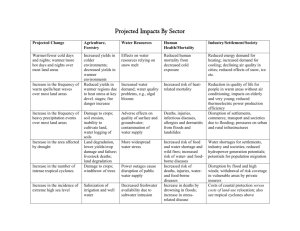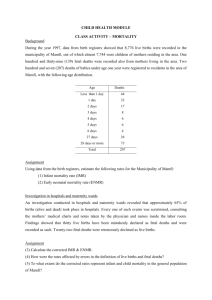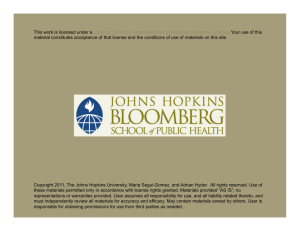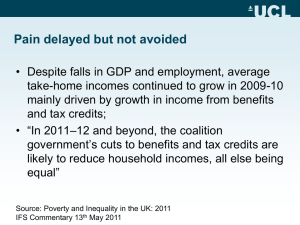Asian Journal of Medical Sciences 2(2): 66-69, 2010 ISSN: 2040-8773
advertisement
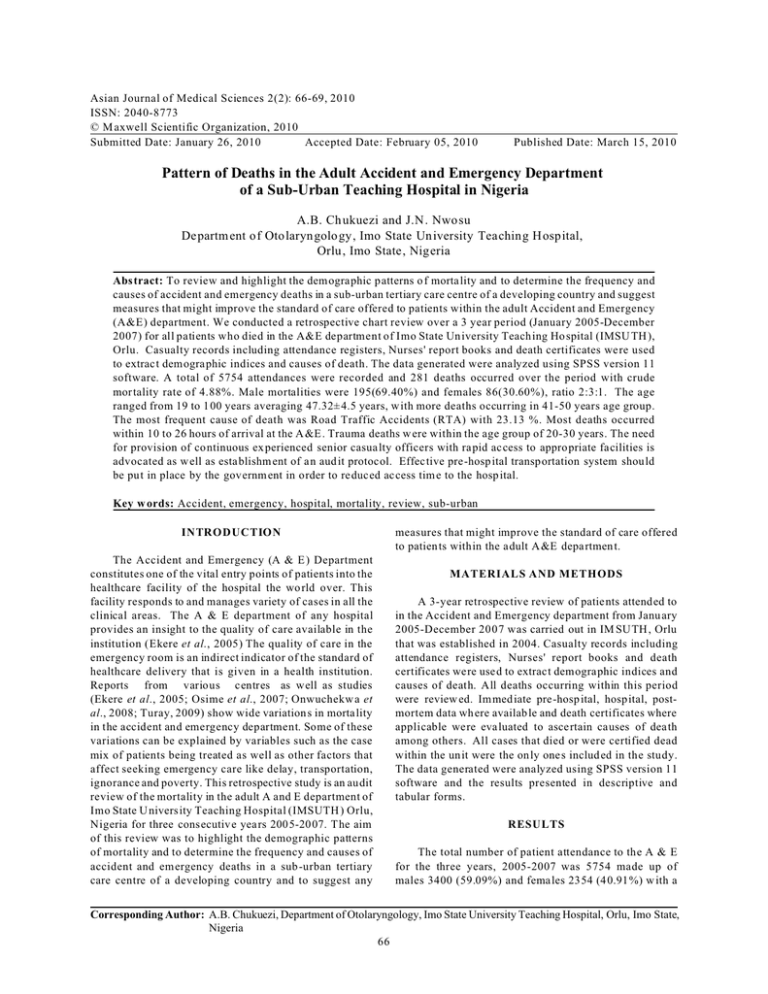
Asian Journal of Medical Sciences 2(2): 66-69, 2010 ISSN: 2040-8773 © M axwell Scientific Organization, 2010 Submitted Date: January 26, 2010 Accepted Date: February 05, 2010 Published Date: March 15, 2010 Pattern of Deaths in the Adult Accident and Emergency Department of a Sub-Urban Teaching Hospital in Nigeria A.B. Ch ukuezi and J.N . Nwosu Departm ent of Otolaryn golo gy, Imo State University Teaching Hospital, Orlu , Imo State, Nigeria Abstract: To review and highlight the dem ographic p atterns o f mortality and to determine the frequency and causes of accident and emergency deaths in a sub-urban tertiary care centre of a developing country and suggest measures that might improve the standard of care offered to patients within the adult Accident and Emergency (A&E) department. We conducted a retrospective chart review over a 3 year period (January 2005-December 2007) for all patients who died in the A&E department of Imo State University Teach ing Ho spital (IMSU TH ), Orlu. Casualty records including attendance registers, Nurses' report books and death certificates we re used to extract demographic indices and causes of death. The data generated were analyzed using SPSS version 11 software. A total of 5754 attendances were recorded and 281 deaths occurred over the period with crude mortality rate of 4.88%. Male mortalities were 195(69.40%) and females 86(30.60%), ratio 2:3:1. The age ranged from 19 to 100 years averaging 47.32±4.5 years, w ith more deaths occurring in 41-50 years age group. The most frequent cause of death was Road Traffic Accidents (RTA) with 23.13 %. Most deaths occurred within 10 to 26 hours of arrival at the A &E . Trauma deaths w ere within the age group of 20-30 years. The need for provision of co ntinuous ex perienced senior casua lty officers with ra pid access to appro priate facilities is advocated as well as establishm ent of an aud it protocol. Effec tive pre-hosp ital transportation system shou ld be pu t in place by the governm ent in order to reduced access tim e to the hosp ital. Key w ords: Accident, emergency, hospital, mortality, review, sub-urban INTRODUCTION The Accident and Emergency (A & E ) Department constitutes one of the vital entry points of patients into the healthcare facility of the hospital the wo rld over. This facility responds to and manages variety of cases in all the clinical areas. The A & E department of any hospital provides an insight to the quality of care available in the institution (Ekere et al., 2005) The quality of care in the emergency room is an indirect indicator of the standard of healthcare delivery that is given in a health institution. Reports from various centres as well as studies (Ekere et al., 2005; Osime et al., 2007; Onwuchekw a et al., 2008; Turay, 2009) show wide variation s in mortality in the accident and emergency department. Some of these variations can be explained by variables such as the case mix of patients being treated as well as other factors that affect seeking emergency care like delay, transportation, ignorance and poverty. This retrospective study is an au dit review of the mortality in the adult A and E department of Imo State U niversity Teaching Hospital (IMSUTH ) Orlu, Nigeria for three consecutive years 200 5-2007. The aim of this review was to highlight the demographic patterns of mortality and to determine the frequency and causes of accident and em ergency deaths in a sub -urban tertiary care centre of a developing country and to suggest any measures that might improve the standard of care offered to patien ts within the adult A &E depa rtmen t. MATERIALS AND METHODS A 3-year retrospective review of patients attended to in the Accident and Emergency department from Janu ary 2005-December 2007 was carried out in IM SU TH , Orlu that was established in 2004. Casualty records including attendance registers, Nurses' report books and death certificates were used to extract demographic indices and causes of death. All deaths occurring within this period were review ed. Immed iate pre-hosp ital, hospital, postmortem data wh ere availab le and death certificates where applicable were evaluated to asce rtain causes of death among others. All cases that died or were certified dead within the unit were the only one s includ ed in the study. The data generated were analyzed using SPSS version 11 software and the results presented in descriptive and tabular forms. RESULTS The total number of patient attendance to the A & E for the three years, 2005-2007 was 5754 made up of males 3400 (59.09%) and females 2354 (40.91%) w ith a Corresponding Author: A.B. Chukuezi, Department of Otolaryngology, Imo State University Teaching Hospital, Orlu, Imo State, Nigeria 66 Asian J. Med. Sci., 2(2): 66-69, 2010 Table 1: Attendance of patient to the A & E imsuth 2005-2007 Sex 2005 2006 2007 Total M ale 1035 978 1387 3400 Fem ale 661 681 1012 2354 Total 1696 1659 2399 5754 male to female ratio of 1.4:1. and a notab le increase in attendance over the years (Table 1). Two hundred and eighty-one (281) deaths were recorded over the period with a crude m ortality rate of 4.88% . Male d eaths were 195(69.40%) and females 86(30.60%), with a ratio of 2.3:1. The age range was 19 to 100 years with mean of 47.32±4.5 years. The highest number of deaths was within the 41–50 age groups (Table 2). Majority of deaths were below 50 years. Considering the total number of patients’ attendance to the A & E, the mortality rate stood at males 3.39% and females 1.49%. The yearly mortality was 58(20.64 %), 99 (35.23%) and 124(44.13%) for 2005, 2006 and 2 007 respectively. The m onthly spread of mortality (Table 3), showed that the highest number of deaths was recorded in September. There is no explanation for this observation. The highest clinical cause of death w as RT A (n = 65) (Table 4). Most mortality occurred within 10 to 26 hours of arrival at the A&E. Majority of trauma deaths were within the age group of 20-3 0 yea rs. The total num ber of d eath-onarrival or brought-in-dead (BID) was 56 (19.93%) . DISCUSSION Tab le 2: A ge d istribu tion o f the m ortality Age group No. of deaths 0–10 0 11–20 8 21–30 32 31–40 51 41–50 76 51–60 43 61–70 35 71–80 25 81–90 10 91–100 1 Total 281 Table 3: The monthly spread of mortality M onth 2005 2006 2007 Jan 3 3 12 Feb 4 4 5 Mar 4 4 10 Apr 6 8 6 May 5 5 8 Jun 4 11 11 Jul 5 13 13 Aug 6 11 14 Sept 6 15 14 Oct 4 5 9 Nov 4 8 10 Dec 7 12 12 Total 5 8(2 0.6 4% ) 9 9(3 5.2 3% ) 1 24 (4 4.1 3% ) Yearly mortality rates 1.01% 1.72% 2.16% Imo State University Teaching Hospital (IMSUTH) is located in the sub-urban town of Orlu in Imo State of Nigeria. It serves the whole State with a population of 3.5 million people and was established in 2004. In present study a total of 281 deaths were recorded out of 5754 patients treated in the A&E showing a crude mortality rate of 4.88%. A similar study in Port-H arcou rt, Nigeria in an urban Teaching Hospital over a 3 year period (Ekere et al., 2005) reported a crude mortality rate of 2%. The mark ed difference in the m ortality rate could be due to the urban setting and superior infrastructural facilities that are available to the older and bigger h ospital in PortHarcourt. Other local studies reported m ortality rates of 6.8% (Onwuchekwa et al., 2008) 4.7% in Freetown, Sierra Leone (Turay, 2009 ) and 5 .2% in Benin, N igeria (Osime et al., 2007) However our male to female ratio of 2.3:1 which shows more male deaths is comparable and consistent with reports by most other studies (Ekere et al., 2005; Osime et al., 2007; Onwuchekwa et al., 2008; Turay, 2009) carried out locally in Nigeria and worldwide (Adesunkanmi et al., 2002; Cothren et al., 2007; Moshiro et al., 2001). This is not surprising as men especially the younger age group are involved in all mann ers of activity. Males are more likely to be involved in violent activities and m otor ve hicle crashes, and often sustain more severe injuries com pared to females (Osime et al., 2007). The frequency of causes of death varies from centre to centre as w ell as by regions (Ekere et al., 2004). Mortality in the A&E m ay result from various factors including incompetence of the attending junior physicians, delay in presentation and inadequate facilities Tab le 4: C aus es o f patie nts d eath Aetiology No. RTA 65 BID 56 CVA 31 Acute Abdom en 22 Diabeticcoma 19 CCF 17 Ren alfailure 14 Non Rta Trauma 12 Liver Disease 11 HIV/AIDS/PTB 11 Sep ticaem ia 8 Can cers 5 PPH (Post Partum Haemo rrhrage) 4 Chicken Pox 2 B. Pneumonia 2 M alaria 1 Burns 1 Total 281 P ER (% ) 0.00 2.85 11.39 18.15 27.05 15.30 12.46 8.90 3.56 0.36 100.00 Total 18 13 18 20 18 26 31 31 35 18 22 31 281 P ER (% ) 6.41 4.63 6.41 7.12 6.41 9.25 11.03 11.03 12.45 6.41 7.82 11.03 100.00 4.88% P ER (% ) 23.13 19.93 11.03 7.83 6.76 6.05 4.98 4.27 3.91 3.91 2.85 1.78 1.42 0.71 0.71 0.36 0.36 100.00 (Onwuchekwa et al., 2008). Majority of deaths in our series were below 50 years167 (59.44%) with a peak at 41-50 years age group 76(27.05%). B ecke tt et al. (1987) in a study of deaths in A&E departments of three London hosp itals noted that many of the patients that died in A&E were elderly in which 66% of the patients who died w ere over 60 years. The marked difference with our finding 67 Asian J. Med. Sci., 2(2): 66-69, 2010 could be attributed to advanced medical care and facilities and, longevity in the developed counties like Britain. Trauma related deaths constituted the most common cause of mortality with Road Traffic Accidents (RTA) being the most common cause 23.13%. (n = 65). RTA has consistently been reported as the major cause of deaths in the A &E in Nigeria – 41.6% (Osime et al., 2007) 57.8% (Ekere et al., 2004 ) 70.5% (Adesun kanmi et al., 2002) 75% (Solagberu , 2002) as well studies carried out all over the world (Y agmu r et al., 1999; Cothren et al., 2007; Siddiqui et al., 2004; Moshiro et al., 2001; Solagberu et al., 2003a, b; Pikoulis et al., 1999; No rdberg, 200 0). Aptly stated the incidence of trauma deaths is on the increase, partly due to rapid gro wth of motorised transport and to expansion of industrial production without adeq uate safety precautions (Gordon et al., 1989 ). W e found that the age group mainly inv olved in R TA were those between 20-30 years. Osime et al. (2007) noted that the age group from 21-40 years is usually very active and mob ile and often co ntributes a greater percentage of nation’s economic work force. Other agents of trauma deaths noted included falls (A desu nkanmi et al., 2002; Cothren et al., 2007). Gunshot w ounds, blows and blunt trauma. Macleod et al. (2004) stated that the independent indicators of mortality, which are untreatable in trauma, included head injury, increasing ag e, and injury se verity score. Bec kett et al. (1987) in their study showed that Myocardial infarction/Ischaemic heart disease were the commonest cause of death in the A&E - 35 out of 63 deaths (55.56 %). T his is likely due to different life styles here and in Britain. The second leading cause of death in our series was ‘brought-in-dead’ (BID) with no known cause of death. These were cases certified dead in the A & E who died either at hom e or in tran sit and summed up as pre-hospital deaths. It is worrisome that the actual cause of death in this group of cases remained undetermined, as autopsy was not done on them. This was due largely to local myths that doing so would make them re-incarnate with missing parts. This belief has been held tenaciously despite religious inclination. In a retrospective study by Khan et al. (2007) they reported a high 70% of their mortality cases who were dead-onarrival while Ekere et al. (2005) recorded 3.6% of the cases dead-on -arrival. Other causes of mo rtality were Cardiovascular Accident (CV A) 31 (11.03% ); Acu te Abdomen 22 (7.83% ); Congestive Cardiac Failure (CCF) 17 (6.05% ); Diabetic com a 19 (6.76% ) and Renal failure 14 (4.98%). Sepsis was responsible for 8 (2.85%) of deaths in our series as against 23% recorded by Khan et al. (2007) H IV/AIDS deaths were 11 (3.9% ). Liver diseases, burns and malaria were among the other aetiologies of death in the study. The leading factors contributing to mortality were identified to include: inade quate pre-hospital transfer (Ekere et al., 2005; Siddiqui et al., 2004). Limited hospital resources, poor infrastructures on gro und, delay in presentation and treatment absence of integrated and organised trauma care, lapses in inter-hospital commun ications, error in judgement and inadequate clinical exposure by the first line junior casualty officers in the accident and emergency department.. W e observed that no matter h ow adeq uate and efficient a hospital facility is, it can only be effectively utilized if it is accessible within a reasonable time. Increased journey distance to the hospital in the rural and sub-u rban areas appe ars to be asso ciated with increased risk of mortality. A 10 km increase in straightline distance is associated with around a 1% increase in mortality. In Nigeria there is gross inadequacy of prehospital transportation and the ambulan ce system is almost none existent. As observed by B ecke tt et al. (1987) a survey such as this to identify deaths in A&E department is a simple form of audit of care given and care received by the most seriously ill patients. It allows comparisms to be made and ide ntifies areas where improvemen ts are desirable. A greater awareness of the problems in the running o f A& E depa rtment and m ore aggressive approach to care and treatment is advocated. This will go a long way in improving the standard of care offered to the patients. Dearden and Rutherford (1985) stressed the importance of senior cover in the A&E department. In their study in Nottingham, all seriously injured patients are seen b y a more experienced doctor, day and night, either in a supervisory role, or as the ‘primary doctor’. They believe that this is in the best interest of patients but also the best method of teaching resuscitation technique to casualty officers. In as much as this suggestion is plausible our hospital cannot afford to post senior doctors in the A&E as there is paucity of specialists and docto rs in this ca dre. CONCLUSION The difficulties involved in delivery of care in the A&E are highlighted after review of mortalities. It is recommended that as a newly established health facility, there should be improvement in manage ment techniques, provision of adequate facilities and standards of first line responders. The need for provision of continuous experienced senior casualty office rs with rapid access to appropriate facilities is advocated as well as establishment of proper audit protocol. Effective and efficient prehospital transportation system no doubt should be put in place by the government in order to reduced access time to the hospital. This will contribute in reduction on mortality in the A&E. REFERENCES Adesunkanmi, A.R., A.A. Akinkuolie and O.S. Badru, 2002. A five year analysis of death in accident and emergency room of a semi-urban hospital. W est Afr. J. Med., Apr.-Jun., 21(2): 99-104. 68 Asian J. Med. Sci., 2(2): 66-69, 2010 Beckett, M W ., P.M. Longstaff, M.J. McCabe, D.A. Sulch and M.J. W ard, 19 87. D eaths in three accident and Emergency Departments. Arch. Emerg. Med., 4: 227-232. Cothren, C.C., E.E. Moore, H.B. Hedegaard and K. Meng, 2007 . Epidemio logy of Urban Trauma Deaths: A Comprehensive R eassessm ent 10 Y ears Later. World J. Surg., May 16. Dearden, C.H. and W.H. Rutherford, 1985. The resuscitation of the severely injured in the accident and emergency department – a medical audit. Injury, 16: 249-252. Ekere, A.U., B.E. Yellowe and S. Umune, 2004. Surgical mortality in the emergency room. Int. Orthop., Jun, 28(3): 187-190. Ekere, A.U., B.E. Yellowe and S. Umune, 2005. Mortality patterns in the accident and emergency department of an urban hospital in Nigeria. Niger J. Clin. Pract., Jun, 8(1): 14-18. Gordon, M.W ., C. Luke, C.E. Robertson and A . Busuttil, 1989. An audit of trauma deaths occurring in the accident and Emergency Department. Arch. Emerg. Med., 6(2): 107-115. Khan, N.U ., J.A. Razzak, S.M.H. Alam and H. Ahmed, 2007. Emergency department deaths despite active management: Experience from a tertiary care centre in a low-income country. Emerg. Med. Austral., 19(3): 213-217. Macleod, J., M. Lynn, M.G. M cKenney, I. Jeroukhimov and S.M. Cohn, 2004. Predictors of Mortality in trauma patients. Am. J. Surg., Sep., 70(9): 805-810. Moshiro, C., R. Mswia, K.G. Alberti, D.R. Whiting and N. Unwin, 2001 . AM MP Project Team. The importance of injury as a cause of death in subSaharan Africa n: results of a community-based study in Tanzania. Public Health, March, 115(2): 96-102. Nordberg, E., 2000. Injuries as a public health problem in sub-Saharan African: Epidemiology and p rospe cts for control. East Afr. Med. J., December, 77(12 suppL): S1-43. Onwuchekw a, A.C ., E.G. Asekom eh, A .M . Iyagba and S.I. Onung., 2008. Medical mortality in the accident and emerge ncy unit of the University of Port Harcourt Teachin g Hospital. Niger J. Med., A prilJune, 17(2): 182-185. Osime, O.C., S.U. Ighedosa, O.O. Oludiran, P.E. Iribhog be, E. Ehikham enor and S .O. Elusoji, 2007. patterns of trauma deaths in an accident and emergency unit. Prehosp. D isaster Me d., 22(1): 7578. Pikoulis, E., F. Karlis, C. Theos, P. Koulouvaris, A. Gera nios, S. Kiose, A. Tsamatropoulos and S. Mantonakis, 1999. Road traffic accident related morbidity and mortality as seen in an emergency department. Critical Care, 3(Su ppl 1): 229. do i: 10.1186/cc602. Siddiqui, A.A., H. Zafar and S.H. Bashir, 2004. An audit of head trauma care and mortality. J. Coll Physicians Surg. Pak., March, 14(3): 173-177. Solagberu, B.A ., 2002 . Spina l cord injuries in Ilorin, Nigeria, West Afr. J. Med., 21(3): 230-232. Solagberu, B.A., A.O. Adekanye, C.P. Ofoegbu, U.S. Udoffa, L.O. Abdur Rhaman and J.O. Taiwo, 2003a. Epidemiology of trauma deaths. West Afr. J. Med., June, 22(2): 177-181. Solagberu, B.A ., A.T. Duze, S.A. Kuranga, A.O. Adekanye, C.K. Ofoegbu and E.O. Odelowo, 2003b. Surgical emergencies in a Nigerian U niversity Hosptial. Niger Postg rad. M ed. J., Septem ber, 10(3): 140-143. Turay, B.S., 2009. Sierra Leone: Connaught Hospital Scales Down Mortality Rate.http://www.allafrica. com/stories/200902171031.html Yagmur, Y., M. Kiraz and H. Kara, 1999. Looking at trauma and deaths: Diyarbir city in Turkey. Injury, March, 30(2): 111-114. 69


